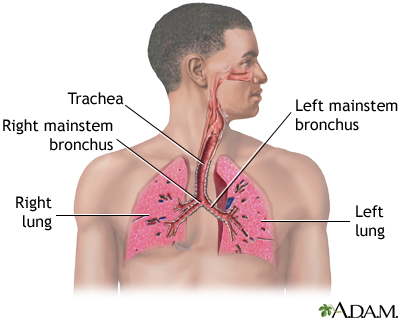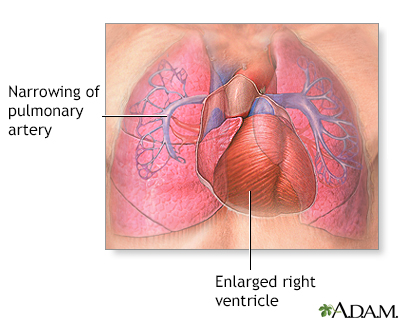Pulmonary hypertension
Pulmonary arterial hypertension; Sporadic primary pulmonary hypertension; Familial primary pulmonary hypertension; Idiopathic pulmonary arterial hypertension; Primary pulmonary hypertension; PPH; Secondary pulmonary hypertension; Cor pulmonale - pulmonary hypertension
Pulmonary hypertension is high blood pressure in the pulmonary arteries of the lungs. It makes the right side of the heart work harder than normal.
Images


Presentation

I Would Like to Learn About:
Causes
The right side of the heart pumps blood into the pulmonary artery and then through the lungs, where it picks up oxygen. Blood returns to the left side of the heart, where it is pumped to the rest of the body.
When the small arteries (blood vessels) of the lungs become narrowed, they cannot carry as much blood. When this happens, pressure builds up. This is called pulmonary hypertension.
The heart needs to work harder to force the blood through the vessels against this pressure. Over time, this causes the right side of the heart to become larger and malfunction. This condition is called right-sided heart failure, or cor pulmonale.
Pulmonary hypertension may be caused by:
- Autoimmune diseases that damage the lungs, such as scleroderma and rheumatoid arthritis
- Birth defects of the heart
- Blood clots in the lung (pulmonary embolism)
- Heart failure (of the left side of the heart)
- Heart valve disease
- HIV infection
- Low oxygen levels in the blood for a long time (chronic)
- Lung disease, such as COPD or pulmonary fibrosis or any other severe chronic lung condition
- Medicines (for example, certain diet medicines)
- Obstructive sleep apnea
In rare cases, the cause of pulmonary hypertension is unknown. In this case, the condition is called idiopathic pulmonary arterial hypertension (IPAH). Idiopathic means the cause of a disease is not known. IPAH affects more women than men.
If pulmonary hypertension is caused by a known medicine or medical condition, it is called secondary pulmonary hypertension.
Symptoms
Shortness of breath or lightheadedness during activity is often the first symptom. Fast heart rate (palpitations) may be present. Over time, symptoms occur with lighter activity or even while at rest.
Other symptoms include:
- Ankle and leg swelling
- Bluish color of the lips or skin (cyanosis)
- Chest pain or pressure, most often in the front of the chest
- Dizziness or fainting spells
- Fatigue
- Increased abdominal size due to fluid buildup
- Weakness
People with pulmonary hypertension often have symptoms that come and go. They report good days and bad days.
Exams and Tests
Your health care provider will perform a physical exam and ask about your symptoms. The exam may find:
- Abnormal heart sounds
- Feeling of a pulse over the breastbone
- Heart murmur on the right side of the heart
- Larger-than-normal veins in the neck
- Leg swelling
- Liver and spleen swelling
- Normal breath sounds if pulmonary hypertension is idiopathic or due to congenital heart disease
- Abnormal breath sounds if pulmonary hypertension is from other lung disease
In the early stages of the disease, the exam may be normal or almost normal. The condition may take several months to diagnose. Asthma and other diseases may cause similar symptoms and must be ruled out.
Tests that may be ordered include:
- Blood tests
- Cardiac catheterization
- Chest x-ray
- CT scan of the chest
- Echocardiogram
- Electrocardiogram (ECG)
- Lung function tests
- Nuclear lung scan
- Pulmonary arteriogram
- 6-minute walk test
- Sleep study
- Tests to check for autoimmune problems
Treatment
There is no cure for pulmonary hypertension. The goal of treatment is to control symptoms and prevent more lung damage. It is important to treat medical disorders that cause pulmonary hypertension, such as obstructive sleep apnea, lung conditions, and heart valve problems.
Many treatment options for pulmonary arterial hypertension are available. If you are prescribed medicines, they may be taken by mouth (oral), received through the vein (intravenous, or IV), or breathed in (inhaled).
Your provider will decide which medicine is best for you. You will be closely monitored during treatment to watch for side effects and to see how well you are responding to the medicine. Do not stop taking your medicines without talking to your provider.
Other treatments may include:
- Blood thinners to reduce the risk of blood clots, especially for some forms of pulmonary hypertension
- Oxygen therapy at home
- Lung transplant, or in some cases, heart-lung transplant, if medicines do not work
Other important tips to follow:
- Avoid pregnancy.
- Avoid heavy physical activities and lifting.
- Avoid traveling to high altitudes.
- Get a yearly flu vaccine, as well as other vaccines such as the pneumococcal (pneumonia vaccine), and the COVID-19 vaccine.
- Stop smoking.
Outlook (Prognosis)
How well you do depends on what caused the condition. Medicines for IPAH may help slow the disease.
As the illness gets worse, you will need to make changes in your home to help you get around the house.
For people with severe disease, lung transplant, or in some cases, heart-lung transplant can be considered.
When to Contact a Medical Professional
Contact your provider if:
- You begin to develop shortness of breath when you are active
- Shortness of breath gets worse
- You develop chest pain
- You develop other symptoms
- You feel lightheaded or dizzy
- You have persistent palpitations
Related Information
Heart failureReferences
Lammi MR, Mathai SC. Pulmonary hypertension: general approach. In: Broaddus VC, Ernst JD, King TE, et al, eds. Murray and Nadel's Textbook of Respiratory Medicine. 7th ed. Philadelphia, PA: Elsevier; 2022:chap 83.
Maron BA. Pulmonary hypertension. In: Libby P, Bonow RO, Mann DL, Tomaselli GF, Bhatt DL, Solomon SD, eds. Braunwald's Heart Disease: A Textbook of Cardiovascular Medicine. 12th ed. Philadelphia, PA: Elsevier; 2022:chap 88.
BACK TO TOPReview Date: 5/3/2024
Reviewed By: Allen J. Blaivas, DO, Division of Pulmonary, Critical Care, and Sleep Medicine, VA New Jersey Health Care System, Clinical Assistant Professor, Rutgers New Jersey Medical School, East Orange, NJ. Review provided by VeriMed Healthcare Network. Also reviewed by David C. Dugdale, MD, Medical Director, Brenda Conaway, Editorial Director, and the A.D.A.M. Editorial team.

Health Content Provider
06/01/2025
|
A.D.A.M., Inc. is accredited by URAC, for Health Content Provider (www.urac.org). URAC's accreditation program is an independent audit to verify that A.D.A.M. follows rigorous standards of quality and accountability. A.D.A.M. is among the first to achieve this important distinction for online health information and services. Learn more about A.D.A.M.'s editorial policy, editorial process and privacy policy. A.D.A.M. is also a founding member of Hi-Ethics. This site complied with the HONcode standard for trustworthy health information from 1995 to 2022, after which HON (Health On the Net, a not-for-profit organization that promoted transparent and reliable health information online) was discontinued. |
The information provided herein should not be used during any medical emergency or for the diagnosis or treatment of any medical condition. A licensed medical professional should be consulted for diagnosis and treatment of any and all medical conditions. Links to other sites are provided for information only -- they do not constitute endorsements of those other sites. © 1997- 2025 A.D.A.M., a business unit of Ebix, Inc. Any duplication or distribution of the information contained herein is strictly prohibited.
